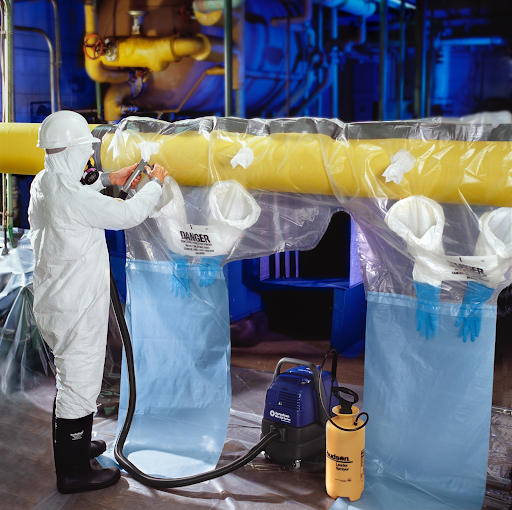
You may be aware that asbestos is still a common feature in many buildings, more than two decades after the majority of countries banned the substance. Yet the sources of asbestos we talk about are usually in plain sight, or at least accessible. Asbestos lagging, insulation, panels and even toilet seats are all common in old buildings, and having a good awareness of the risk around asbestos is key.
What fewer people know about is the asbestos that’s underneath us. Thousands of miles of pipes are made of asbestos cement, and age is causing them to degrade. You would think the risks of consuming asbestos would be similar to inhaling it – but what’s the truth, and should we be worrying about asbestos pipes?
Asbestos in infrastructure
Asbestos exposure is sadly a common occurrence even in 2021. Although asbestos hasn’t been in active use in most parts of the world since the late 90s, the asbestos that’s still in buildings and certain products has begun to degrade. Accidental damage, unwitting renovations and general wear and tear can all cause asbestos fibers to come loose and be breathed in, to deadly effect.
Asbestos was used all throughout infrastructure, particularly in the post-War period, when much of the world was being extensively rebuilt. The cost and risks of removing it often seem to be higher than simply leaving it in place and ‘maintaining’ it, in as much as that is possible. This is particularly true when it comes to asbestos cement pipes, which pervade the water supplies of many major countries.
Largely fitted in the 1950s and 60s, asbestos was used to strengthen cement as an affordable and durable building material. Widely used as sheeting for roofs and walls in countries such as Australia and New Zealand, asbestos cement pipes were favored for their resilience under high pressures, and lightweight construction compared to metal equivalents.
It’s estimated that around a fifth of people in the UK drink water which has passed through asbestos cement pipes, which make up 257,000 kilometers of the network. In Italy this is 125,000 km, while in the United States and Canada, estimates put the proportion of asbestos cement pipes at 18%. Parts of the U.S. West Coast also sit on top of asbestos rock deposits, polluting drinking water before it reaches the pipes.
Slow progress
While asbestos pipes are durable, they can and do degrade, and operatives with Asbestos Awareness training are required to repair and reline them. This is a known problem, and authorities in many countries do test the water supply to ensure that asbestos levels do not breach the maximum values set under law, currently 7 million fibers per liter in the United States. If this sounds like a lot, it’s better than the UK, which has no legal limit for the amount of asbestos in water.
The UK has so far acted on the advice of the WHO, which maintained until 2014 that there was no link between the consumption of asbestos (as opposed to inhaling asbestos) and ill health. However, a 2011 report from the Journal of Toxicology and Environmental Health demonstrated “a strong association between asbestos exposure and peritoneal neoplasms (growths in and around the digestive tract)”. Their belief was that this was most easily explained by the consumption of asbestos due to “exposure from pipelines containing chrysotile asbestos”.
Since 2014, the WHO has shifted its stance. While they have not called for governments to actively remove asbestos cement pipes, they now highlight that since there is no safe threshold for asbestos exposure of any kind, governments should “stop using all types of asbestos”. Yet despite this, the UK government seems yet to have taken any action. Communities around the UK are still being exposed to polluted drinking water, which evidence suggests could be causing an increased risk of cancer.
Driving change
The fact that ingesting asbestos is similarly damaging to inhaling it shouldn’t come as a surprise. We know that the danger of asbestos is how tiny the fibers are, and how this allows them to penetrate deep into the cells in our lungs, causing persistent damage. It stands to reason that these fibers could also be absorbed into our digestive tracts, and that they would have a similar potential to cause cancer there as they do in the lungs.
Of course, many factors elevate our risk of developing cancer. Evidence is growing that microplastics, tiny particles from disposable plastic items, have made their way into our food and water, and are equally capable of being absorbed by our cells. Awareness of air pollution is perhaps higher than it’s ever been, and the effects this can have on our cognition. And lead pipes and leaded fuel are an issue we’ve only just got past – and in some cases (such as the US town of Flint, Michigan) are still getting past.
That isn’t a reason we shouldn’t be concerned about all of those factors, though, particularly as rates of cancer seem to increase year by year. When solving the problem of asbestos in the water supply is as simple as replacing aging, broken pipes, that shouldn’t be too much to ask. By putting pressure on water suppliers and both local and national governments to take the threat of waterborne asbestos seriously, we can tackle the issue now – and stem the tide of cancer deaths from asbestos.
–Lee Sadd is the Training & Operations Director at SAMS Ltd, a leading health & safety training and consultancy provider in the UK. SAMS offers a range of accredited safety courses online and in person, as well as consulting and assessments for businesses of all sizes.
